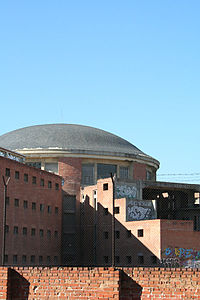- Carabanchel Prison
-
Prisión Provincial de Madrid 
Location Carabanchel, Madrid, Spain Coordinates 40°22′53″N 3°45′19″W / 40.3815°N 3.7553°W Population 2,000 (men) & 500 (women) (as of 1999) Closed 1999 Carabanchel Prison was constructed by political prisoners after the Spanish Civil War between 1940 and 1944 in the Madrid's neighbourhood of Carabanchel. It was one of the biggest prisons in Europe until its closure in 1998. The structure followed the panopticon model devised by Jeremy Bentham in 1785.
Contents
History
During General Francisco Franco's regime (1936–1975) the prison hosted a large community of political prisoners, which included relevant members of democratic and leftist political parties and union leaders. Notable inmates included Marcelino Camacho (leader of the Communist clandestine union Comisiones Obreras) and the rest of top-rank members of it imprisoned as a result of the Process 1001, Julián Ariza (member also of the same union), Nicolás Redondo (leader of Workers' General Union), Eduardo Saborido, Simón Sánchez Montero (Communist leader, who server 25 years in prison),[1] José María Ruiz Gallardón (monarchist opponent to the dictatorship and father of the current Mayor of Madrid Alberto Ruiz Gallardón),[2] Nicolás Sartorius,[3] Ramón Tamames,[4] Enrique Múgica and Enrique Curiel (Communist activists), Miguel Boyer (Socialist activist and a minister later),[5] Fernando Sánchez-Dragó,[6] Miguel Gila,[7] Fernando Savater,[8] Fernando Arrabal,[9] CNT member Luís Andrés Edo and would-be Franco assassins Stuart Christie and Fernando Carballo Blanco. After Franco's death, only common criminals and terrorists belonging to the Basque terrorist group ETA and other paramilitary groups remained.
After its abandonment[10], the building was heavily looted and was inhabited by marginal communities. Most of the prison walls were covered with graffiti, some of them very elaborate. A lengthy debate took place between the neighbours from Carabanchel and Aluche, who wanted a hospital and other public facilities to be built in the area[11], and the local authorities, who want to privatize the land for housing development. The neighbours also wanted part of the prison to be preserved as a memorial to the struggle for democracy in Spain.
Finally in July 2008, local and national government reached an agreement on the future of the prison lot, projecting to build 650 apartments, a hospital, green zones and government buildings on the former prison grounds. Despite protests the entire Carabanchel complex was demolished in late 2008.
Notes
- ^ Una placa conmemorativa en la antigua cárcel de Carabanchel recordará a las víctimas de la represión franquista, Europa Press, 21 June 2008.
- ^ "Interior obtendrá cerca de 70 millones con la cárcel de Carabanchel" (in Spanish). El País. http://www.elpais.com/articulo/madrid/Interior/obtendra/cerca/millones/carcel/Carabanchel/elpepiespmad/20080617elpmad_6/Tes. Retrieved 2008-06-21.
- ^ Los últimos de Carabanchel, Magazine de El Mundo
- ^ El Defensor del Pueblo empieza a defenderlo, in Ramón Tamames' blog.
- ^ Los «rojos» vuelven a la cárcel de Carabanchel... de visita, El Mundo, 19 November 1998.
- ^ Tras 50 años de búsqueda, el pasado verano Sánchez Dragó localizó el cadáver de su padre, El Mundo, 22 February 2004.
- ^ La cárcel de Carabanchel pide un hueco en la memoria histórica, Soitu, 19 September 2008.
- ^ ¿El final de la cordura?, tribuna de Fernando Savater en El País, 3 November 2008]
- ^ Perfiles: Arrabal - Un eterno rebelde
- ^ Photos from Carabanchel after the abandonment
- ^ The neighbours' project for the prison lot
References
- Chance, C. (2005) Carabanchel: The Last Brit in Europe's Hellhole Prison. Mainstream.
- Díaz Cardiel, V. (2007) "Algunos recuerdos de mis cuatro estancias en la cárcel de Carabanchel" El Rapto de Europa 11: 13-19.
- Photos from the prison [1]
- Photos from Carabanchel at flickr.com [2]
External links
 Media related to Carabanchel Prison at Wikimedia CommonsCategories:
Media related to Carabanchel Prison at Wikimedia CommonsCategories:- Defunct prisons in Spain
- Buildings and structures in Madrid
- History of Madrid
Wikimedia Foundation. 2010.

